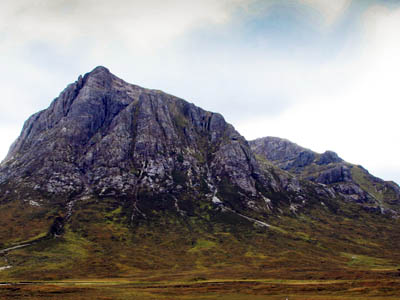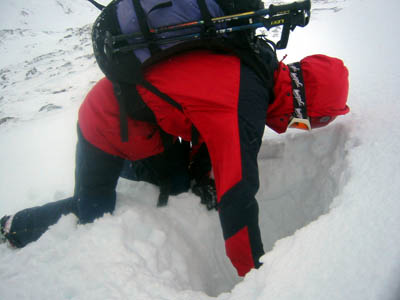
Buachaille Etive Mòr
More details emerged today of the avalanche which claimed the lives of three mountaineers in the Highlands, as police released the names of the dead men.
Eamonn Murphy, 61, of Carrickfergus, County Antrim, Northern Ireland, and his brother John Murphy, of Portrush, County Antrim, were killed on Buachaille Etive Mòr along with Brian Murray, 46, of Monifieth, Angus.
Walker Tom Richardson of Sheffield was walking alone, ahead of two separate parties, when the avalanche occurred. The 54-year-old slid down the mountain to get a mobile phone signal and raise the alarm.
Jim Coyne, 50, of East Kilbride, Lanarkshire, survived the avalanche, extricating himself from the snow and spent ten minutes digging out his walking colleague David Barr, 53, of Paisley, Renfrewshire, after seeing his arm sticking out of the debris.
He said the snow which broke away was not corniced, but came away as a slab.
Mr Barr had suffered injuries to his shoulder. As they dropped down off the mountain, worried they would suffer hypothermia, they encountered the group of seven walkers who had been below them.
The pair witnessed one of the party trying to revive his companion by mouth-to-mouth resuscitation. They offered to help but were told to get Mr Barr down to safety because of his injuries. It took them two hours to get back down to the valley bottom. Mr Barr’s injuries were treated at Belford Hospital, Fort William.
Dave Grieve, of Glencoe Mountain Rescue Team, said those killed in the avalanche died of asphyxiation. Two were pronounced dead at Belford Hospital and one at the Southern General Hospital, Glasgow.
He said the party of seven belonged to a Scottish mountaineering club.
The rescuers were dropped by helicopter below the scene of the avalanche and had to climb up to the site. When they got there, fellow walkers were using ice axes to locate their buried companions and dig them out of the tons of snow.
grough correspondent Dave Hewitt points out this is not the first tragedy to happen in the corrie. The Scottish Mountaineering Club’s journal describes another triple fatality in 1995, when the bodies of three people lay buried in deep snow for more than five weeks.
The journal reported how a 50-year-old research engineer, his son, 18, and son’s friend, also 18, were engulfed in a huge avalanche in Lagangarbh Corrie, Buachaille Etive Mor.
Lagangarbh is the club’s hut directly below Coire na Tulaich and the name is sometimes extended to the corrie. The incident happened on 22 February.
The accident report says: “With the engineer’s wife they had walked into the floor of the corrie, not intending to go any higher.
“At 2pm she had gone down and got worried when they did not rendezvous at 4pm as arranged. That same night Glencoe Mountain Rescue Team found a large amount of debris, which had come from the south down the main line of the corrie.
“While searching, members of the rescue team had been narrowly missed by a second large avalanche from the west wall of the corrie. Search and Rescue Dog Association searches, trenching and probing were carried out over the next three days by Glencoe, Kinloss and Leuchars MRTs and RAF Sea Kings.
“Snow depth was estimated as 20m (66ft) which could not be reached with specially extended probes, even from trenches dug by the rescuers as deep as six metres with which the area was criss-crossed.”
It was not until snow had sufficiently melted to a depth of 4m (13ft) that rescue dog Inca found the missing walkers and they were recovered by Kinloss MRT.
The survival rate for those buried in avalanches declines rapidly the longer they remain under the snow. With a covering of less than one metre, it drops from 92 per cent if extricated immediately to 64 per cent within an hour. A study in Switzerland found only 19 per cent of completely buried people survive.

Digging a snow pit to assess avalanche risk in the Highlands
Soft slab avalanches are the most common type in Britain, with a rapid build up of wind-blown snow, often in lee slopes, and are nearly always set off by their victims.
The potential of a slope’s risk to avalanche can be assessed by walkers and climbers performing various tests on snow with a similar aspect to that which is to be crossed, but is free from avalanche risk.
A snow pit can be dug, to assess the different layers of build-up, and then a simple wedge block test, using a shovel, ice axe or even gloved hands, can determine how easily different layers break away.
Fifteen minutes spent assessing avalanche risk can be a lifesaver.
Assessors from the sportscotland Avalanche Information Service, who go out on to the mountains every day in winter, use a Rutsch block test, which is a more detailed type of wedge test and uses a 1 to 5 scale to determine how easily layers of snow become attached.
Buachaille Etive Mòr means Great Shepherd of Etive in Gaelic.
- Glencoe Mountain Rescue Team also had to go to the aid of a lone mountaineer who had fallen off nearby Aonach Eagach the same afternoon.
He was airlifted to hospital by an RAF helicopter, but suffered only minor injuries.
Lenore
26 May 2018I love what you guys tend to be up too. This sort of
clever work and exposure! Keep up the superb works guys I've added you guys to my blogroll.
amendola maglia milan